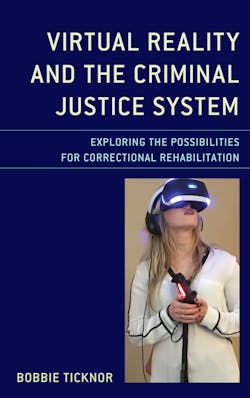Book Review: Virtual Reality and the Criminal Justice System
Innovative ideas in correctional rehabilitation seem to capture a small bit of media attention from teaching life skills, allowing inmates to hold themselves responsible for a dog’s training, gardening, to even producing their own theater productions. While studies report that integrating technology into the program can assist with furthering someone’s education—and potentially lowering recidivism—are there other ways technology might be able to support the criminal justice system?
Bobbie Ticknor, an assistant professor of criminal justice at Valdosta State University argues that there are: “We are also seeing [virtual reality technology] applied in many other areas to address real-world problems. The criminal justice system should be no exception.”
Published by The Rowman & Littlefield Publishing Group, Inc., Ticknor writes about the potential virtual reality (VR) could provide the criminal justice system, specifically in correction rehabilitation. Before getting deep into observations, arguments and supporting evidence, the book opens by providing the reader with a historical perspective of VR.
You’ll need to know the definition, where the technology concept came from, how it started, and how it stands today. Ticknor pulls no punches and quickly walks you through the history. It may sound unimportant, but having a grasp of this information will be greatly beneficial later. A bit of background can help. What you’ll find is a connection from the gadgets seen in the booths of high-tech entertainment conferences like CES to its use in law enforcement and criminal justice.
Ticknor writes in the introduction, “While most people think of VR in terms of entertainment and gaming, it has also been used in a variety of disciplines, including criminal justice, to study and solve real-world problems. The following chapters will explore how VR is used in the field and how it can be expanded to address some of the challenges facing the criminal justice system today.”
The book breaks down VR into three main system types based on user interaction instead of the hardware involved. This seems to go against the grain on other naming conventions for technology-based categories: desktops refer to the harddrive on a desk; a laptop fits on your lap; a handheld device is held in your hand; etc., etc. Time will tell if this is evident of a trend on naming modern technology based on use rather than form. Whether these are Ticknor’s labels or not is not clear. I, for one, have VR as a personal interest and am always on the watch for ways the technology can help law enforcement—so, this categorization is greatly appreciated. Ticknor explains that one could consider their monitor, computer, or tablet as non-immersive, semi-immersive as “use high-performance graphics and projectors, screens or special cameras to display the virtual environment,” and fully-immersive as utilizing a HMD (head-mounted display) to immerse the user in a 360-degree environment.
After this introduction, Ticknor provides a pair of chapters providing current-use examples of VR in and out of law enforcement. This ranges from equipment simulators, for use in education, addressing behavioral disorders as well as training simulators like VirTra and crime scene reconstruction.
The book then gets to its “meat and potatoes” and connects VR to the correctional environment by offender assessment and treatment. By now the reader has a good grasp of its potential. It hopes the reader can take that and be open to new ideas and avenues. There are new opportunities in more industries the technology can address. Ticknor points out the potential straightforward and quite well. Using examples and explanation about how VR can be implemented, the book argues VR can be used in offender assessment with physiological response tracking, evaluate decision making, and responsivity issues “by identifying other underlaying disorders that are often associated with, or exacerbate, criminal behavior.” Later, a chapter covers treatment and how VR might be able to enhance criminal behavior therapy by the following areas.
- Skill training
- Roleplaying
- Addressing various types of mental illnesses and disorders
Not wanting to leave the reader without advice, the fifth chapter presents a pilot study noting strengths, areas of improvement as well as recommendations for implementation. Ticknor ends with a briefing and goes over key takeaway items.
If you’re interested in the topic or researching new avenues in using technology within rehabilitation, consider Ticknor’s book and consider the argument.
Additional Resources on VR Technology & Simulation Training
The correctional industry is not the only place VR technology has found a niche, here are few items worth checking out:
- "Virtual Reality: A Reality for Crime Scene Training" by Rebecca Kanable. Officer.com/10812441, originally published in LET November 2012. Kanable profiles the National Forensic Science Technology Center's efforts with the University of Tennessee Law Enforcement Innovation Center making virtual reality crime scene training available to state and local law enforcement professionals.
- "Train in Virtual Reality" by Adrienne Zimmer, Editor Officer.com/20992185, originally published in LET March 2018. Zimmer writes about how through technological advancement, virtual reality simulators offer law enforcement the ability to practice a multitude of skills in a controlled, life-like environment before hitting the streets.
- "The Interface in Your Face" by Jonathan Kozlowski, Managing Editor. Officer.com/11567920, originally published in LET August 2014. A look at augmented reality systems, their state at the time and potential use in public safety and law enforcement.
- "Getting the 'Big Picture" by Bob Galvin. Officer.com/10233199, originally published in LET October 2009. Galvin explains the technology used in 3D scanning and point clouds as they relate to digitally capturing a crime scene.
- "Shooting Range Reset" by Hilary Romig. Officer.com/12268113, originally published in LET November 2016. Romig discusses augmenting firearm ranges with a simulation system keeping in mind budget, space, and skill development.
SMART Papers
- "Add a Virtual Simulator to Your Law Enforcement Toolbox" by Meggitt Training Systems. Officer.com/20988106
- "The Next-Generation of Firearms Training Simulators" by DART Firearms Training Simulator / Digimation. Officer.com/12363803
- "The Role of Virtual Simulation in Law Enforcement Training" by Panasonic. Officer.com/20993687
- "Facing Today's Law Enforcement Training Challenges Head On" by VirTra. Officer.com/21004242
About the Author

Jonathan Kozlowski
Jonathan Kozlowski was with Officer.com, Law Enforcement Technology, and Law Enforcement Product News from August 2006 to 2020.
As former Managing Editor for Officer Media Group, he brought a dedicated focus to the production of the print publications and management of the Officer.com online product and company directory. You can connect with Jonathan through LinkedIn.
Jonathan participated as a judge for the 2019 and 2020 FOLIO: Eddie & Ozzie Awards. In 2012, he received an APEX Award of Excellence in the Technology & Science Writing category for his article on unmanned aerial vehicles (UAVs) in police work, aptly titled "No Runway Needed".
